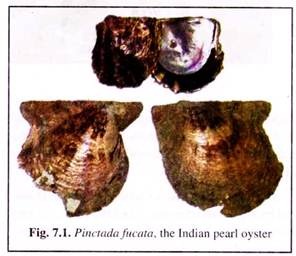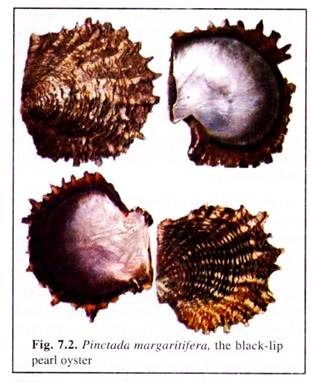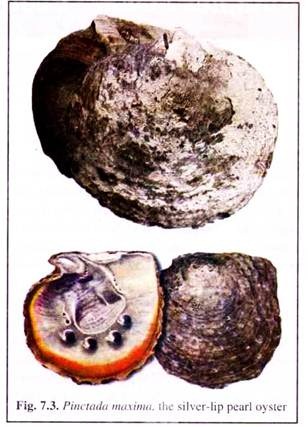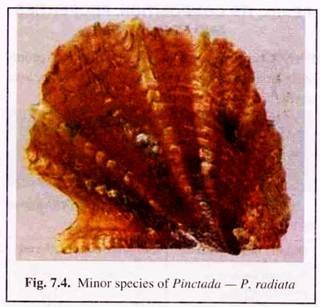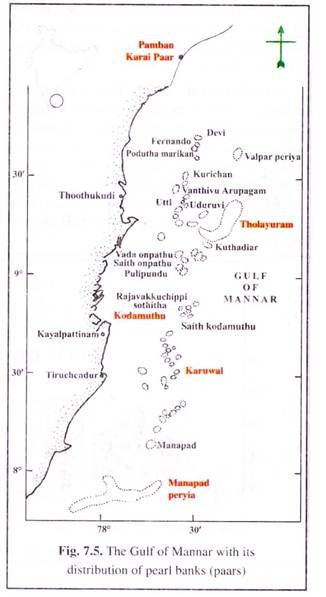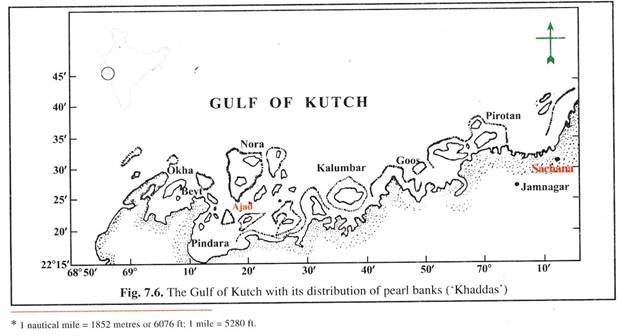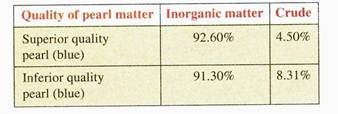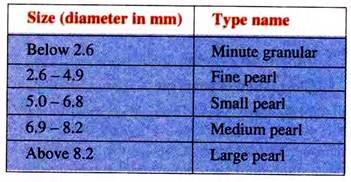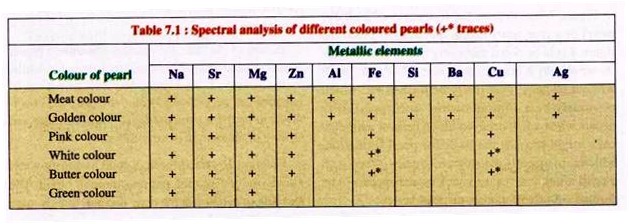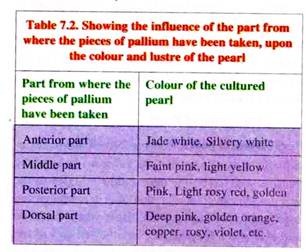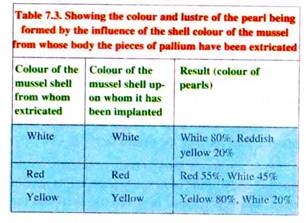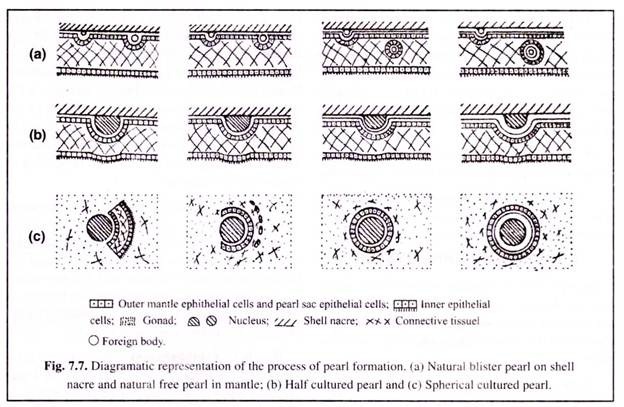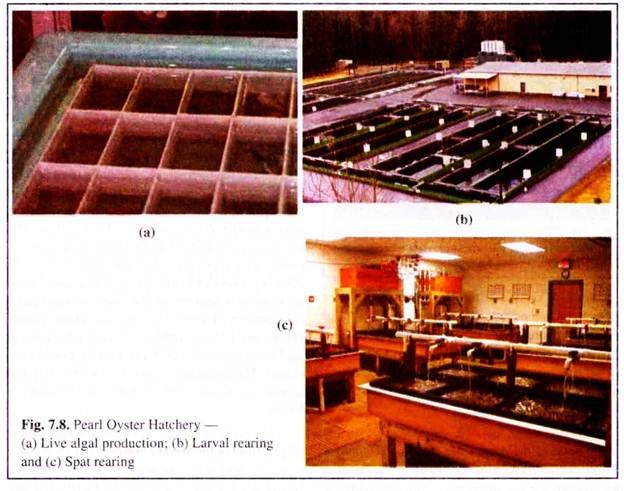In this article web will discuss about Pearl:- 1. Meaning of Pearl 2. Types of Pearls 3. Pearl Producing Molluscs 4. Pearl Fisheries of India 5. Chemical Composition 6. Properties 7. Formation 8. Uses 9. By-Products.
Meaning of Pearl:
The word ‘pearl’ is derived from the Latin word pirula which means pear, that is in accordance to the pear shape of the pearls. The beauty of pearl is an object of adoration and a barometer of wealth. Pearl is counted among the nine gems and needs no cutting or polishing to bring out its lustre. All over the world, pearl has been a subject of folklore and is also a subject of one of the most modern sciences — genetic engineering.
The credit for the production and development of modern pearl culture goes to Japan. The initial success was achieved in 1893 by Kokichi Mikimoto, who is considered as the ‘Pearl King’ and the Father of Pearl Culture industry. From the initial success the technique of pearl culture was developed and perfected.
In India the technological breakthrough in pearl culture was achieved in 1973 by the Central Marine Fisheries Research Institute (CMFRI) at Tuticorin. A second, equally significant, breakthrough was achieved in 1981, through the development of controlled production of pearl oysters in hatchery.
ADVERTISEMENTS:
Pearl oysters are gregarious and they remain attached to rocks, live or dead corals, other mollu- scan shells or to other hard substrate. They remain at a depth of 10-12 fathoms about 20 km off the shore. The pearl banks in the Gulf of Mannar are known as ‘paars’ and the intertidal beds in the Gulf of Kutch as ‘khaddas’.
Types of Pearls:
(a) Natural pearls:
Natural pearls may be formed within the oyster or mussels by either accidental entrance of a solid or accidental wound within the shell muscles or tissues. Pearls so produced are called natural pearls and are very rare because of their accidental origin.
(b) Cultured pearls:
ADVERTISEMENTS:
Cultured pearls are produced by human interference, when the pearls are produced through the process of culture of pearl producing oysters or mussels.
(c) Artificial pearls:
Such pearls are cheap imitations made of plastics, glass, fish scales, etc. with an artificial luster.
Pearl Producing Molluscs:
Any mollusc, which has the mother-of-pearl layer on the inner surface of its shell, is generally capable of producing a pearl. However, pearl as a jewel is only produced by a few species, which are listed below.
ADVERTISEMENTS:
A. Marine pearls:
(a) Pearl oysters:
Pinctada fucta, Pinctada margaritifera and Pinctada maxima are the three prime species of pearl oysters and produce superior quality pearls.
(i) Pinctada fucata (Gould):
It is commonly known as the Indian pearl oyster. It was formerly known as P. vulgaris in India and P. martensii in Japan. Both these species are now known as P. fucata (Fig. 7.1). Its distributions are in the Indian subcontinent, Japan and the Persian Gulf.
In India it occurs in the Gulf of Kutch (coast of Gujarat) and in the Gulf of Mannar (off the coast of Tamil Nadu). In the Gulf of Mannar the natural pearls produced by this oyster were the famous ‘Lingah’ pearls or Oriental pearls.
Pinctada fucata occurs in the intertidal area to a depth of 12 fathoms. It grows up to a size of 9 cm.
Its maximum lifespan is about 7 years.
ADVERTISEMENTS:
(ii) Pinctada margaritifera (Linnaeus):
This oyster is commonly known as the black-lip pearl oyster (Fig. 7.2). It has a very wide distribution. In India it occurs at the intertidal region of Andaman- Nicobar Islands. The black-lip pearl oyster grows to about 17 cm in shell height.
(iii) Pinctada maxima (Jameson):
This oyster is generally known as the gold-lip or silver-lip pearl oyster (Fig. 7.3). It is the largest and best, of all the pearl oysters in the world. Its distribution is restricted and is seen in Australia, Papua New Guinea, China, Philippines, Thailand, Myanmar and Indonesia. It also occurs in the Andaman and Nicobar islands.
Pinctada mxima occurs from low tide level to about 40 fathoms depth. The species grows to about 28.2 cm in diameter and the pair of shells weigh up to 5.5 kg.
(iv) Minor pinctada species:
The following minor Pinctada species (Fig. 7.4) are not considered very important as far as pearl production is concerned.
Pearls are occasionally produced by these oysters, which are listed below:
Pinctada albina carcharium is present in Shark Bay (Australia). The pearls produced have strong iridescence with colours such as light yellow, light brown, light green or light pink.
Pinctada albino sugillata occurs in India (Gulf of Mannar) and Australia. It grows up to 11 cm.
Pinctada maculata is observed in Australia.
Pinctada chemnitzii is observed in India and Australia.
Pinctada imbricata is known from Venezuela and Bermudas. The pearls afe translucent with colours varying among white, light pink or yellow.
In the Indian waters two other species of Pinctada are also recorded — Pinctada atropurpurea and Pinctada anomioides.
(b) Winged oysters:
Winged oyster (Pteria penguin) rarely produces pearls.
(c) Windowpane oysters:
Placenta placenta, commonly known as windowpane oyster, produces seed pearls of minute size. They are not considered as gems but are used for medicinal purposes.
(d) Sea mussel:
Sea mussels such as Mytilus edulis. Pern a viridis and P.indica occasionally produce seed pearls which are not considered as gem.
(e) Giant clam:
Tridacna, the giant clam, produces occasionally large sized pearls, as big as a golf ball.
(f) Gastropods:
The gastropod, Haliotis species, produces multi-coloured irregular pearls, especially red and green in colour.
B. Freshwater pearls:
Freshwater pearls are produced by freshwater mussels belonging to Unionaceae. Some of the notable species used are Hyriopsis schlegelii of Japan, Cristaria plicata of China and species of Lamellidens. In India and South Asia Lamellidens marginalis is used.
Pearl Fisheries of India:
(A) Gulf of mannar:
The Indian pearl fisheries in the Gulf of Mannar along with Sri Lanka produces the true oriental pearls of the finest quality. The species common to this area is Pinctada fucata.
In 1922, Hornell listed a total number of 72 pearl banks known as ‘paars’. ‘Paar’ means a patch of hard ground of very low profile. These paars are located in line, parallel to and at a distance of 10-16 nautical miles from land. This is stretched from Pamban Karai Paar in the north (head of Gulf of Mannar) to Manapad Periya Paar in the south (Fig. 7.5).
Among these 72 beds, quite a large number of them have not yielded any fisheries at any time. In general, the pearl fisheries at Tholayuram paar, Kodamuthu group and Karuwal group have been relatively consistent in the production of pearl than the others.
Another pearl fishery is situated in the Palk Bay off Toudi, which economically is not a successful fishery as the oysters are of inferior quality than those of Gulf of Mannar.
(B) Gulf of kutch:
In the Gulf of Kutch there are about 42 pearl oyster reefs, known as ‘Khaddas’. The intertidal area of the Gulf of Kutch, borders the coastline of Jamnagar District and covers a total area of about 24,000 ha, from Sachana in the east to Ajad in the west (Fig. 7.6). ‘Khadda’ means a hard bottom of coral and rocky area with an admixture of mud and sand. Pearl oysters of the species Pinctada fucata is found here.
Chemical Composition of Pearl:
According to Bolman (1941), the nacreous pearl of Pinctada has the following composition:
Superior and inferior quality pearl is determined by the following way:
The mineral calcium carbonate is secreted by the pearl-sac epithelium in two forms — aragonite crystals and calcite crystals. The third form of vaterite crystals has not been reported in the pearl oyster. The real ‘nacre’ substance is aragonite while calcite is the prismatic substance.
Although four types of cultured pearl products are known (organic, prismatic, nacreous and compound), it is only the nacreous product that is accepted as pearl.
Properties of Pearl:
Classification of pearls:
Pearls are classified according to the size as given below:
Factors responsible for the production of coloured pearls:
(1) The depth of oyster culture and light penetration is related with the lustre and colour of the pearl.
(2) Lustre increases with the increase of rearing period of pearl oyster.
(3) A relation exists between the colour of the cut pieces of the pallium of the ‘donor’ and the colour and lustre of the pearl.
(4) Availability and quality of food phytoplankton content has distinct effect on the colour and lustre of the pearls via its role of energy supply.
(5) Amount of trace element present influences the colour of pearl.
Texture and colour of pearl:
Good quality pearls are determined by their lustre and colour. The colour of the pearl is related to the metallic elements present in the oysters environment. This has been analysed through spectral analysis of different coloured pearls.
It has been observed that cream-coloured and golden-coloured pearls contain good quality of copper and silver while much sodium and zinc were reported to be present in meat-coloured and pink-coloured pearls. The results of the spectral analysis is furnished in Table 7.1.
Studies revealed that the colour of the pearls is determined mainly by the colour of the cut pieces of the pallium and the part from where they are cut (Table 7.2). Further, the colours of the shell of the mussel also have marked influence on the colour and lustre of pearls (Table 7.3).
Formation of Pearl:
(a) Natural pearl:
Pearl is formed due to secretion of the mantle tissue. The nacreous layer of the pearl is secreted by the outer epithelial layer of the mantle. This layer has the capability to rearrange and regenerate itself and remain viable when disturbed and also when transplanted in other tissues of the animal. The inner epithelium and the connective tissue, on the other hand, would disintegrate when transplanted.
A natural pearl is formed by the following way:
(1) The outer epithelial layer of the mantle accidentally falls into the body of the pearl oyster.
(2) It regenerates a sac consisting of a single layer of cells, thus forming the pearl sac.
(3) Sometimes a foreign body accidently enters into the body of the oyster, when the shells remain open, and gets trapped between the shell and the mantle. The outer epithelium of the mantle invaginates and form the pearl sac.
(4) Inside the pearl sac, as a result of secretion of nacre, a natural pearl grows.
(5) The secretion of nacre continues till the end of life of the pearl oyster, thereby forming/producing a beautiful, natural pearl.
Figure 7.7(a) depicts the formation of a blister pearl or a free pearl inside the mantle. From the figure it is to be noted that every pearl has a nucleus (however tiny it may be) at its core. However, ‘pearl without nucleus’ may rarely be formed and would obviously be a contradiction.
Such possibility occurs when a few decayed blood cells or epithelial cells might provide the basis for pearl formation, which subsequently disintegrates totally. When such a pearl is cut, it reveals no nucleus and appears to be formed entirely of mother-of-pearl layers.
(b) Cultured pearl:
The technique of the formation of natural pearl is manipulated in the cultured pearl formation process.
Here for the formation of pearl, the two pre-requisites are:
(1) The outer epithelium of the mantle lobe and
(2) A core substance or nucleus.
(i) Formation of pearl sac:
Here, a small piece of mantle from a donor oyster is grafted skillfully into the gonad of the recipient oyster along with a nucleus. The outer epithelium of the grafted mantle piece regenerates itself around the implanted nucleus and forms a pearl sac.
This pearl sac secretes and deposits nacre or mother-of-pearl around the nucleus, thus resulting into a pearl (Figs. 7.7 b & c). As this pearl is produced through manipulation (surgery) in the oyster and by further cultivation of the seeded oyster, it is thus called the cultured pearl. The half- pearl (as shown in Fig. 7.7b) is produced by inserting the nuclei on the nacreous face of the shell at appropriate sites.
(ii) Secretion of pearl forming matters:
Initially, after the formation of pearl sac, its internal part is alkaline and the secretion contains organic substances such as Keratin. The secretion is due to the prismatic layer containing calcites. The internal part of pearl sac later becomes acidic and subsequently neutral. The secretive matter ultimately becomes pearl forming material.
(iii) Calcium absorption and formation of calcium carbonate:
The main ingredient of pearl is calcium carbonate (calcite and aragonite). In pearl oysters the main source of calcium is food. However, the gill, mantle and fool can directly absorb calcium from water.
In case of the gills, the calcium absorption power is strong and its rejection capacity is meagre, while, in the mantle both absorption and rejection of calcium are very strong. Thus, the gills are considered to be the most ideal organ for absorption and storing of calcium in pearl oysters.
Calcium absorbed through food and from water slowly moves into the pallium through blood. The carrying of calcium in the body depends mainly upon the role played by alkaline phosphatase present in the epithelial cells of the connective tissue and mantle of the pearl sac. Alkaline phosphatase combines with the calcium ion (Ca+2) to form phosphate and other salts.
The calcium ion in the presence of phosphatase gains energy and passes through the mantle to be absorbed by its epidermal cells. This is then carried to the connective tissue of the pearl sac.
In the course of its passage the Ca+2 also unites with the cartilaginous sulphate (a compound protein of acidic nature). It further induces the calcium ion to become active and is transported to the cytoplasm of nacreous layer and ultimately excreted by the epidermal cells.
The excreted calcium then under the activity of carbonic acid releasing hydrase combines with the carbon dioxide (released by the body of the mussel due to metabolic activity) and ultimately forms calcium carbonate.
It has been reported that the concentration of carbon dioxide determines the nature of crystal formation. In the presence of increased CO2 in the aquatic environment calcium carbonate forms sleek-like crystals, while it takes the shape of calcite when CO2 decreases in the environment.
(iv) Factors influencing secretion of nacre:
(1) Morphological structure of the epidermal cells of pearl sac:
As the secretion from the epidermal cells results in the formation of pearl, the healthy condition of these cells and the quality of pearls formed by them are closely related.
It has been seen that nacres, producing regular pearls, are constituted of flat epithelial cells and lacking in either granular or mucous cells. Moreover, pearl sacs responsible for the formation of hard pearls are composed of bubble- shaped epithelial tissues, while high-rising collumnar cells produce soft pearls.
Furthermore, it was observed that the morphological structure of the epidermal cells of pearl sac are not stable and undergo seasonal and environmental changes.
(2) Calcium carbonate crystallization:
Formation of calcium carbonate crystals is wholly determined by the environmental conditions.
(3) Amount of CO2:
The amount of CO2 determines the nature of crystal formation.
(4) Temperature and pH:
In alkaline pH and high temperature granpel form of crystal is formed. Therefore, pearl culture should be undertaken in neutral or low alkaline medium. Temperature controls the rate of deposition of nacre and is accelerated between February and August when the temperature is high.
(5) In the presence of common salt or calcium phosphate, calcium carbonate crystallises into calcite.
(6) Crystallisation of calcium carbonate in granpel form is favoured by the presence of urea, and salts of ammonia, magnesium and strontium.
Uses of Pearl:
(1) Used as an ornament and a symbol of grandeur.
(2) Used in ornamental handicraft.
(3) It is a very precious medicine for surgery, pediatrics, ENT, etc. as used by the Chinese.
By-Products of Pearl:
The by-products of pearl culture is referred to the total mass of the oysters after extraction of the cultured pearl. The by-products of pearl culture are, thus, the seed pearls, shell and the flesh.
(1) The tiny seed pearls (which are unsuitable as a gem) are used in the preparation of medicine.
In India pearl powder and pearl liquid are important ingredients as follows:
(1) Pearl powder is a highly stimulant tonic and aphrodisiac. Its other medicinal values are — laxative, sedative, emetic and nutritive.
(ii) Pearl powders act as an antacid. It is also used in heart burn and bilious affections.
(2) In case of class ‘C’ category of pearls (not used in jewellery), the nacreous layer is removed from the nuclei and ground into a powder. It is then dissolved in phosphoric acid. The final product (pearl calcium tablet) is formed by additional chemical processes. The pearl calcium tablet, thus formed, is marketed in Japan for pregnancies, weak bodies, tooth cavities, stomach acids and allergies.
(3) Large oyster shells, for their mother-of-pearl layer, are used in shell craft.
(4) Small and broken shells are ground and used as ingredients in poultry-feed.
(5) The adductor muscle portion of the flesh of oyster is used for human consumption.
(6) After removal of the pearl, the entrails of the oyster are used for feeding fishes.
